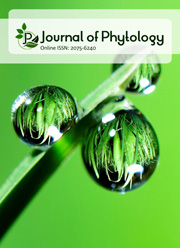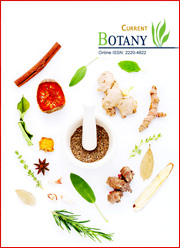Evaluation of antimicrobial and anticancer efficacy of silver nanoparticles phytofabricated by Nyctanthes arbor-tristis L. leaf extract
DOI:
https://doi.org/10.25081/jp.2024.v16.8965Keywords:
Nyctanthes arbor-tristis, AgNPs, Phytochemical analysis, Anitibacterial, Anticancer, CytotoxicAbstract
Nyctanthes arbor-tristis L. (Oleaceae), commonly known as harsingar, is a plant with potential medicinal properties. The plant was used in traditional folk medicine and as a pharmacological activity. The present study reports a rapid and eco-accommodating technique to synthesize silver nanoparticles AgNPs with low cost and with no need to heat, using aqueous extracts of N. arbor-tristis L. Phytochemical analysis was conducted to detect the existence of alkaloids, flavonoids, saturated sugar, saponins, glycosides, steroids, tannins, terpenoids, and proteins in the plant. A color change observed in the test confirmed the synthesis of AgNPs. SEM, XRD, EDX, FTIR, and UV – Visible spectrophotometer (DLS) were used to characterize the synthesized AgNPs. The antibacterial potential of AgNPs was further tested against different bacterial strains such as Escherichia coli, Pseudomonas aeruginosa, Salmonella typhimurium, Staphylococcus aureus and Klebsiella pneumonia displayed by finding the maximum zone of inhibition observed against S. typhi of 24.6 mm, S. aureus 21.6±0.57 mm, P. aeruginosa 19 mm, K. pneumonia 17 mm and E. coli 15.3±0.57 mm. Furthermore, the synthesized AgNPs were also exhibited as anticancer properties against MDA-231 cell line Human Breast cancer cell line which was determined dose dependent manner and their concentration of 2.5 to 30 μg/mL respectively, and noted the inhibitory range at 30 μg/mL of its concentration, which was further tested in high inhibitory effect on their leaf extract high concentration in cytotoxic, bactericidal experiments.
Downloads
References
Agrawal, J., & Pal, A. (2013). Nyctanthes arbor-tristis Linn - A critical ethnopharmacological review. Journal of Ethnopharmacology, 146(3), 645-658. https://doi.org/10.1016/j.jep.2013.01.024
Ahmad, I., & Beg, A. Z. (2001). Antimicrobial and phytochemical studies on 45 Indian medicinal plants against multi-drug resistant human pathogens. Journal of Ethnopharmacology, 74(2), 113-123. https://doi.org/10.1016/s0378-8741(00)00335-4
Anjaneyulu, A. S. R., & Murty, Y. L. N. (1981). The triterpenoid constituents of the leaves of Nycthanthes arbor-tristis Linn. Journal of Indian Chemical Society, 58, 817-818.
Ankita, C., Mamta, G., & Shikha, B. (2014). Antimicrobial Potential of Nyctanthes arbor-tristis and isolation of Colletotrichum Gleosporioides – an endophyte. Journal of Pharmacy Research, 8(8), 1082-1090.
Basu, N. M., Ray, G. K., & De, N. K. (1947). On the vitamin C and carotene contents of several herbs and flowers used in the ayurvedic system of medicine. Journal of Indian Chemical Society, 24, 358-360.
Basu, S., Maji, P., & Ganguly, J. (2016). Rapid green synthesis of silver nanoparticles by aqueous extract of seeds of Nyctanthes arbor-tristis. Applied Nanoscience, 6, 1-5. https://doi.org/10.1007/s13204-015-0407-9
Benwefit, D. (2019). Anticancer activity of Nyctanthes arbor-tristis. International Journal of Advance Research, Ideas and Innovation in Technology, 5(3), 84-87.
Bhatt, L. R., Lim, J. A., & Baek, S. H. (2005). Antimicrobial activity of Nepalese medicinal plants on skin microbial inflammation pathogens. Journal of Community and Public Health, 1, 6-9.
Bhosle, S. M., Huilgol, N. G., & Mishra, K. P. (2005). Enhancement of radiation-induced oxidative stress and cytotoxicity in tumor cells by ellagic acid. Clinica Chimica Acta, 359(1-2), 89-100. https://doi.org/10.1016/j.cccn.2005.03.037
Chatterjee, S. K., Bhattacharjee, I., & Chandra, G. (2007) Bactericidal activities of some common herbs in India. Pharmaceutical Biology, 45(5), 350-354. https://doi.org/10.1080/13880200701212940
Chopra, R. N., Chopra, I. C., Handa, K. L., & Kapur, L. D. (1994). Chopra’s Indigenous Drugs of India, (2nd ed.). Calcutta, India: Academic publishers.
Chung, I.-M., Park, I., Seung-Hyun, K., Thiruvengadam, M., & Rajakumar, G. (2016) Plant-Mediated Synthesis of Silver Nanoparticles: Their Characteristic Properties and Therapeutic Applications. Nanoscale Research Letters, 11, 40. https://doi.org/10.1186/s11671-016-1257-4
Dada, A. O., Inyinbor, A. A., Idu, E. I., Bello, O. M., Oluyori, A. P., Adelani-Akande, T. A., Okunola, A. A., & Dada, O. (2018). Effect of operational parameters, characterization and antibacterial studies of green synthesis of silver nanoparticles using Tithonia diversifolia. PeerJ, 6, e5865. https://doi.org/10.7717/peerj.5865
Darokar, M. P., Mathur, A., Dwivedi, S., Bhalla, R., Khanuja, S. P. S., & Kumar, S. (1998). Detection of antibacterial activity in the floral petals of some higher plants. Current Science, 75(3), 187-189.
Das, S., Sasmal, D., & Basu, S. P. (2008). Anti-inflammatory and antinociceptive activity of arbortristoside-A. Journal of Ethnopharmacology, 116(1), 198-203. https://doi.org/10.1016/j.jep.2007.11.034
Das, S., Sasmal, D., & Basu, S. P. (2010). Antispasmodic and anthelmintic activity of Nyctanthes arbor-tristis Linn. International Journal of Pharmaceutical Sciences and Research, 1(2), 51-55. https://doi.org/10.13040/IJPSR.0975-8232.1(2).51-55
Dib, K., Cherrah, Y., Rida, S., Filali-Maltouf, A., & Ennibi, O. (2021). In vitro antibacterial Activity of Myrtus communis L. and Marrubium vulgare L. Leaves against Aggregatibacter actinomycetemcomitans and Eikenella corrodens. Evidence-Based Complementary and Alternative Medicine, 2021, 8351332. https://doi.org/10.1155/2021/8351332
Dinamani, M., Savaiah, S., & Rao, A. R. (2009). Chemoprevention of DMBA induced skin tumorigenesis in swiss albino mice: a study with Nyctanthes arbor-tristis leaf extract. The Bioscan, 4, 295-299.
Harborne, J. B. (1984). Phytochemical methods. (2nd ed.). New York, US: Chapman and Hall.
Hsin, Y.-H., Chen, C.-F., Huang, S., Shih, T.-S., Lai, P.-S., & Chueh, P. J. (2008). The Apoptotic Effect of Nanosilver is mediated by a ROS- and JNK- dependent Mechanism involving the mitochondrial pathway in NIH3T3 Cells. Toxicology Letters, 179(3), 130-139. https://doi.org/10.1016/j.toxlet.2008.04.015
Jain, A., Katewa, S. S., Galav, P. K., & Sharma, P. (2005). Medicinal plant diversity of Sitamata wildlife sanctuary, Rajasthan, India. Journal of Ethnopharmacology, 102(2), 143-157. https://doi.org/10.1016/j.jep.2005.05.047
Jasim, B., Thomas, R., Mathew, J., & Radhakrishnan, E. K. (2017). Plant Growth and Diosgenin Enhancement Effect of Silver Nanoparticles in Fenugreek (Trigonella foenum-graecum L.). Saudi Pharmaceutical Journal, 25(3), 443-447. https://doi.org/10.1016/j.jsps.2016.09.012
Juan, L., Zhimin, Z., Anchun, M., Lei, L., & Jingchao, Z (2010). Deposition of silver nanoparticles on titanium surface for antibacterial effect. International Journal of Nanomedicine, 2010(5), 261-267. https://doi.org/10.2147/ijn.s8810
Kannan, M., & Singh, R. (2010). An immuno-pharmacological investigation of Indian medicinal plant Nyctanthes arbor-tristis Linn. World Applied Sciences Journal, 11(5), 495-503.
Kaur, J., & Kaushal, S. (1970). Chemical Analysis, Antimicrobial and Antioxidant Activities of Harsingar (Nyctanthes arbor-tristis) essential oil. Journal of Essential Oil Bearing Plants, 23(2), 230-245. https://doi.org/10.1080/0972060X.2020.1759458
Khanapur, M., Avadhanula, R. K., & Oruganti, H. S. (2014). In vitro antioxidant, antiproliferative, and phytochemical study in different extracts of Nyctanthes arbor-tristis flowers. BioMed Research International, 2014(1), 291271. https://doi.org/10.1155/2014/291271
Khatune, N. A., Islam, M. E., Rahman, M. A. A., Mosaddik, M. A., & Haque, E. (2003). In vivo cytotoxic evaluation of a new benzofuran derivative isolated from Nyctanthes arbor-tristis L. on Ehrlich ascite carcinoma cell (EAC) in mice. Journal of Medical Science, 3(2), 169-173. https://doi.org/10.3923/jms.2003.169.173
Lanone, S., & Boczkowski, J. (2006) Biomedical applications and potential health risks of nanomaterials: molecular mechanisms. Current Molecular Medicine, 6(6), 651-663. https://doi.org/10.2174/156652406778195026
Mahida, Y., & Mohan, J. S. S. (2007). Screening of plants for their potential antibacterial activity against Staphylococcus and Salmonella spp. Natural Product Radiance, 6(4), 301-305.
Mathuram, V., Rao, R., Bhima, H., Banerji, S., & Kundu, A. B. (1994). Occurrence of desrhamnosyl verbascoside in Nyctanthes arbor-tristis and NMR studies of its acetate. Journal of Indian Chemical Society, 71(4), 215-217.
Mishra, A. K., Tiwari, K. N., Saini, R., Kumar, P., Mishra, S. K., Yadav, V. B., & Gopal, N. (2020) Green Synthesis of Silver Nanoparticles from Leaf Extract of Nyctanthes arbor-tristis L. and Assessment of Its Antioxidant, Antimicrobial Response. Journal of Inorganic and Organometallic Polymers and Materials, 30, 2266-2278. https://doi.org/10.1007/s10904-019-01392-w
Mosmann, T. (1983). Rapid colorimetric assay for cellular growth and survival: application to proliferation and cytotoxicity assays. Journal of Immunological Methods, 65(1-2), 55-63. https://doi.org/10.1016/0022-1759(83)90303-4
Nair, R., Kalariya, T., & Chanda, S. (2005). Antibacterial activity of some selected Indian medicinal flora. Turkish Journal of Biology, 29(1), 41-47.
Nandiyanto, A. B. D., Rosi, O., & Ragadhita, R. (2019). How to Read and Interpret FTIR Spectroscope of Organic Material. Indonesian Journal of Science and Technology, 4(1), 97-118. https://doi.org/10.17509/ijost.v4i1.15806
Nirmal, S. A., Pal, S. C., & Mandal, S. C. (2012). Analgesic and anti-inflammatory activity of β-sitosterol isolated from Nyctanthes arbor-tristis leaves. Inflammopharmacology, 20, 219-224. https://doi.org/10.1007/s10787-011-0110-8
Orwa, C., Mutua, A., Kindt, R., & Jamnadass, R. A. (2009). Simons. Agroforestree Database: a tree reference and selection guide version 4.0. World Agroforestry Centre, Kenya.
Poddar, A., Banerjee, A., Ghanta, S., & Chattopadhyay, S. (2008). In vivo efficacy of calceolarioside A against experimental visceral leishmaniasis. Planta Medica, 74(5), 503-508. https://doi.org/10.1055/s-2008-1034373
Priya, K., & Ganjewala, D. (2007). Antibacterial activities and phytochemical analysis of different plant parts of Nyctanthes arbor-tristis (Linn). Research Journal of Phytochemistry, 1(2), 61-67. https://doi.org/10.3923/rjphyto.2007.61.67
Qais, F. A., Shafq, A., Khan, H. M., Husain, F. M., Khan, R. A., Alenazi, B., Alsalme, A., & Ahmad, I. (2019). Antibacterial Effect of Silver Nanoparticles Synthesized Using Murraya koenigii (L.) against Multidrug-Resistant Pathogens. Bioinorganic Chemistry and Applications, 2019(1), 1-11. https://doi.org/10.1155/2019/4649506
Rahman, M. M., Roy, S. K., Chowdhury, J. U., & Shahjahan, M. (2011). Chemical composition of leaf and petal oil of Nyctanthes arbor-tristis Linn. Indian Perfumer – Bharatiya Gandhika, 55, 30-36.
Ruparelia, J. P., Chatterjee, A. K., Duttagupta, S. P., & Mukherji, S (2008). Strain specificity in antimicrobial activity of silver and copper nanoparticles. Acta Biomaterialia, 4(3), 707-716. https://doi.org/10.1016/j.actbio.2007.11.006
Santosh, J., & Manojkumar, P. A. (2002) Review on Nyctanthes arbor-tristis Linn. Rejuvenating herbs. International Journal of Research in Pharmacy and Pharmaceutical Science, 1(1), 54-62.
Sathiya, M., Parimala, P., & Muthuchelian, K. (2008). Preliminary phytochemical screening and antibacterial studies on the ethanolic leaf extract of Nyctanthes arbor-tristis Linn. Ethnobotanical Leaflets, 12, 337-342.
Saxena, R. S., Gupta, B., & Lata, S. (2002). Tranquilizing, antihistaminic and purgative activity of Nyctanthes arbor tristis leaf extract. Journal of Ethnopharmacology, 81(3), 321-325. https://doi.org/10.1016/S0378-8741(02)00088-0
Sen, S. K., & Behera, L. M. (2020). Ethno–medicinal uses of Nyctanthesarbor-tristis L. in Bargarh district, Odisha. International Journal of Herbal Medicine, 8(2), 22-24.
Shankar, S. S., Rai, A., Ahmad, A., & Murali, S. (2004). Rapid synthesis of Au, Ag and bimetallic Au core–Ag shell nanoparticles using Neem (Azadirachta indica) leaf broth. Journal of colloid and interface science, 275(2), 496-502. https://doi.org/10.1016/j.jcis.2004.03.003
Singh, A., & Vyas, B. (2018). Night Jasmine (Nyctanthes arbor-tristis), Research Journal of Pharmacognosy and Phytochemistry, 10(4), 324-330. https://doi.org/10.5958/0975-4385.2018.00052.3
Singh, K. L., Roy, R., Srivastava, V., Tandon, J. S., & Mishra, A. (1995). Arborside D, a minor iridoid glucoside from Nyctanthes arbor-tristis. Journal of Natural Products, 58(10), 1562-1564. https://doi.org/10.1021/np50124a012
Singh, S. P., Bhattacharji, S., & Sen, A. B. (1965). Flavonoids of Nyctanthes arbor-tristis. Bulletin of the National Institute of Sciences of India, 31, 41-43.
Srivastava, V., Rathore, A., Ali, S. M., & Tandon, J. S. (1990). New benzoic esters of loganin and 6b-hydroxyloganin from Nyctanthes arbor-tristis. Journal of Natural Products, 53(2), 303-308. https://doi.org/10.1021/np50068a005
Stuppner, H., Mueller, E. P., Mathuram, V., & Kundu, A. B. (1993). Iridoid glycosides from Nyctanthes arbor-tristis. Phytochemistry, 32(2), 375-378. https://doi.org/10.1016/S0031-9422(00)94997-5
Wikler, M. A. (2007). Performance Standards for Antimicrobial Susceptibility Testing: 17th Informational Supplement; C. L. S. I. (Clinical and Laboratory Standard Institute). Journal of Microbiology and Biotechnology, 2(9), 10-17.
Published
How to Cite
Issue
Section
Copyright (c) 2024 P. Kiruba, K. Palanisamy, M. Deepa, P. Srinivasan

This work is licensed under a Creative Commons Attribution 4.0 International License.





 .
.